2004 ISUZU TF SERIES Fuel sensor
[x] Cancel search: Fuel sensorPage 1581 of 4264
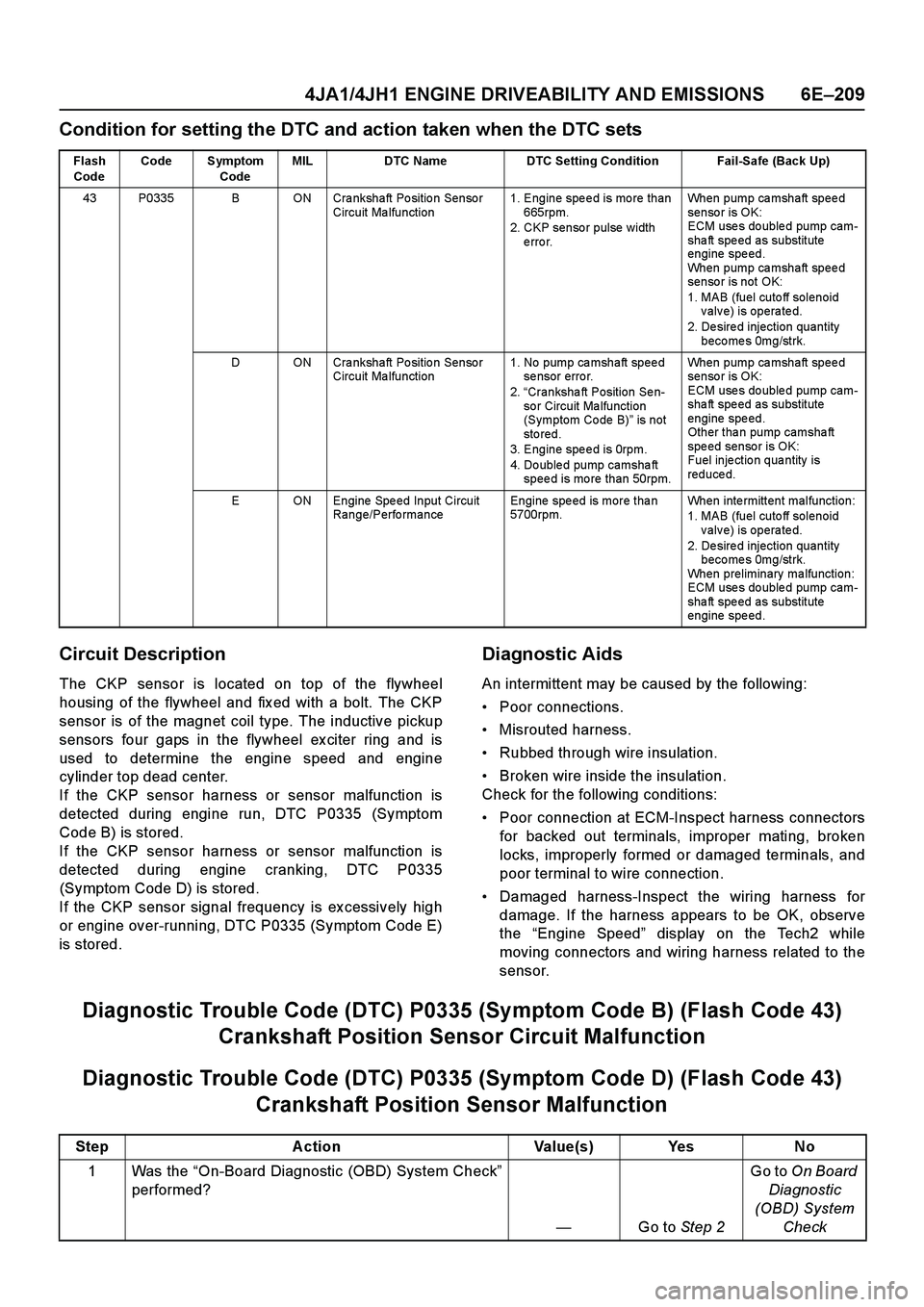
4JA1/4JH1 ENGINE DRIVEABILITY AND EMISSIONS 6E–209
Condition for setting the DTC and action taken when the DTC sets
Circuit Description
The CKP sensor is located on top of the flywheel
housing of the flywheel and fix ed with a bolt. The CKP
sensor is of the magnet coil type. The inductive pickup
sensors four gaps in the flywheel ex citer ring and is
used to determine the engine speed and engine
cylinder top dead center.
If the CKP sensor harness or sensor malfunction is
detected during engine run, DTC P0335 (Symptom
Code B) is stored.
If the CKP sensor harness or sensor malfunction is
detected during engine cranking, DTC P0335
(Symptom Code D) is stored.
If the CKP sensor signal frequency is ex cessively high
or engine over-running, DTC P0335 (Symptom Code E)
is stored.
Diagnostic Aids
An intermittent may be caused by the following:
Poor connections.
Misrouted harness.
Rubbed through wire insulation.
Broken wire inside the insulation.
Check for the following conditions:
Poor connection at ECM-Inspect harness connectors
for backed out terminals, improper mating, broken
locks, improperly formed or damaged terminals, and
poor terminal to wire connection.
Damaged harness-Inspect the wiring harness for
damage. If the harness appears to be OK, observe
the “Engine Speed” display on the Tech2 while
moving connectors and wiring harness related to the
sensor.
Diagnostic Trouble Code (DTC) P0335 (Symptom Code B) (Flash Code 43)
Crankshaft Position Sensor Circuit Malfunction
Diagnostic Trouble Code (DTC) P0335 (Symptom Code D) (Flash Code 43)
Crankshaft Position Sensor Malfunction
Flash
CodeCode Symptom
CodeMIL DTC Name DTC Setting Condition Fail-Safe (Back Up)
43 P0335 B ON Crankshaft Position Sensor
Circuit Ma lfunction1. Engine speed is more than
665rpm.
2. CKP sensor pulse width
e rro r.When pump camshaft speed
senso r is OK:
ECM use s do uble d pump cam-
sha ft spe ed as substitute
engine speed.
When pump camshaft speed
senso r is not OK:
1. MAB (fuel cutoff solenoid
valve) is operated.
2. Desired injection quantity
becomes 0mg/strk.
D ON Crankshaft Position Sensor
Circuit Ma lfunction1. No pump camshaft speed
se nsor erro r.
2.“Cranksha ft Position Se n-
so r Circuit Ma lfunction
(Symptom Code B)” is not
stored.
3. Engine speed is 0rpm.
4. Do uble d pump camsha ft
speed is more than 50rpm.When pump camshaft speed
senso r is OK:
ECM use s do uble d pump cam-
sha ft spe ed as substitute
engine speed.
Other tha n pump camsha ft
speed sensor is OK:
Fuel inje ctio n qua ntity is
reduced.
E ON Engine Speed Input Circuit
Range/PerformanceEngine spe ed is more tha n
5700rpm.When intermittent malfunction:
1. MAB (fuel cutoff solenoid
valve) is operated.
2. Desired injection quantity
becomes 0mg/strk.
When preliminary malfunction:
ECM use s do uble d pump cam-
sha ft spe ed as substitute
engine speed.
Step Action Value(s) Yes No
1Was the “On-Board Diagnostic (OBD) System Check”
performed?
—Go to Step 2Go to On Board
Diagnostic
(OBD) System
Check
Page 1613 of 4264
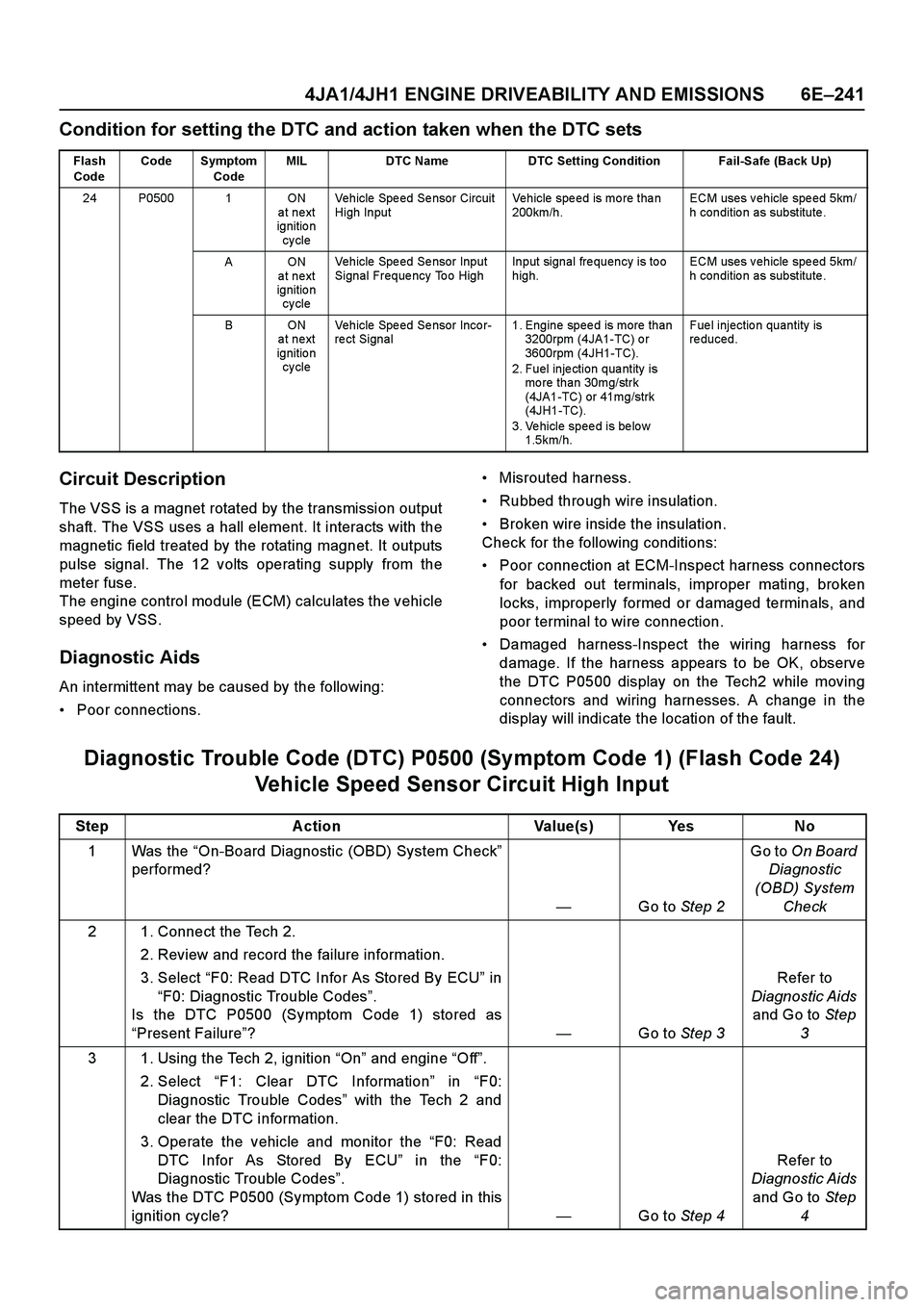
4JA1/4JH1 ENGINE DRIVEABILITY AND EMISSIONS 6E–241
Condition for setting the DTC and action taken when the DTC sets
Circuit Description
The VSS is a magnet rotated by the transmission output
shaft. The VSS uses a hall element. It interacts with the
magnetic field treated by the rotating magnet. It outputs
pulse signal. The 12 volts operating supply from the
meter fuse.
The engine control module (ECM) calculates the vehicle
speed by VSS.
Diagnostic Aids
An intermittent may be caused by the following:
Poor connections.Misrouted harness.
Rubbed through wire insulation.
Broken wire inside the insulation.
Check for the following conditions:
Poor connection at ECM-Inspect harness connectors
for backed out terminals, improper mating, broken
locks, improperly formed or damaged terminals, and
poor terminal to wire connection.
Damaged harness-Inspect the wiring harness for
damage. If the harness appears to be OK, observe
the DTC P0500 display on the Tech2 while moving
connectors and wiring harnesses. A change in the
display will indicate the location of the fault.
Diagnostic Trouble Code (DTC) P0500 (Symptom Code 1) (Flash Code 24)
Vehicle Speed Sensor Circuit High Input
Flash
CodeCode Symptom
CodeMIL DTC Name DTC Setting Condition Fail-Safe (Back Up)
24 P0500 1 ON
at next
ignitio n
cy cleVehicle Spe ed Se nsor Circuit
High InputVehicle speed is more than
200km/h.ECM uses v ehicle spe ed 5km/
h condition as substitute.
AON
at next
ignitio n
cy cleVehicle Speed Sensor Input
Signal Frequency Too HighInput signal frequency is too
high.ECM uses v ehicle spe ed 5km/
h condition as substitute.
BON
at next
ignitio n
cy cleVehicle Spe ed Se nsor Inco r-
re ct Signal1. Engine speed is more than
3200rpm (4JA1-TC) o r
3600rpm (4JH1-TC).
2. Fuel injection quantity is
more than 30mg/strk
(4JA1-TC) or 41mg/strk
(4JH1-TC).
3. Vehicle speed is below
1.5km/h.Fuel injection quantity is
re duced.
Step Action Value(s) Yes No
1Was the “On-Board Diagnostic (OBD) System Check”
performed?
—Go to Step 2Go to On Board
Diagnostic
(OBD) System
Check
2 1. Connect the Tech 2.
2. Review and record the failure information.
3. Select “F0: Read DTC Infor As Stored By ECU” in
“F0: Diagnostic Trouble Codes”.
Is the DTC P0500 (Symptom Code 1) stored as
“Present Failure”?—Go to Step 3Refer to
Diagnostic Aids
and Go to Step
3
3 1. Using the Tech 2, ignition “On” and engine “Off”.
2. Select “F1: Clear DTC Information” in “F0:
Diagnostic Trouble Codes” with the Tech 2 and
clear the DTC information.
3. Operate the vehicle and monitor the “F0: Read
DTC Infor As Stored By ECU” in the “F0:
Diagnostic Trouble Codes”.
Was the DTC P0500 (Symptom Code 1) stored in this
ignition cycle?—Go to Step 4Refer to
Diagnostic Aids
and Go to Step
4
Page 1674 of 4264
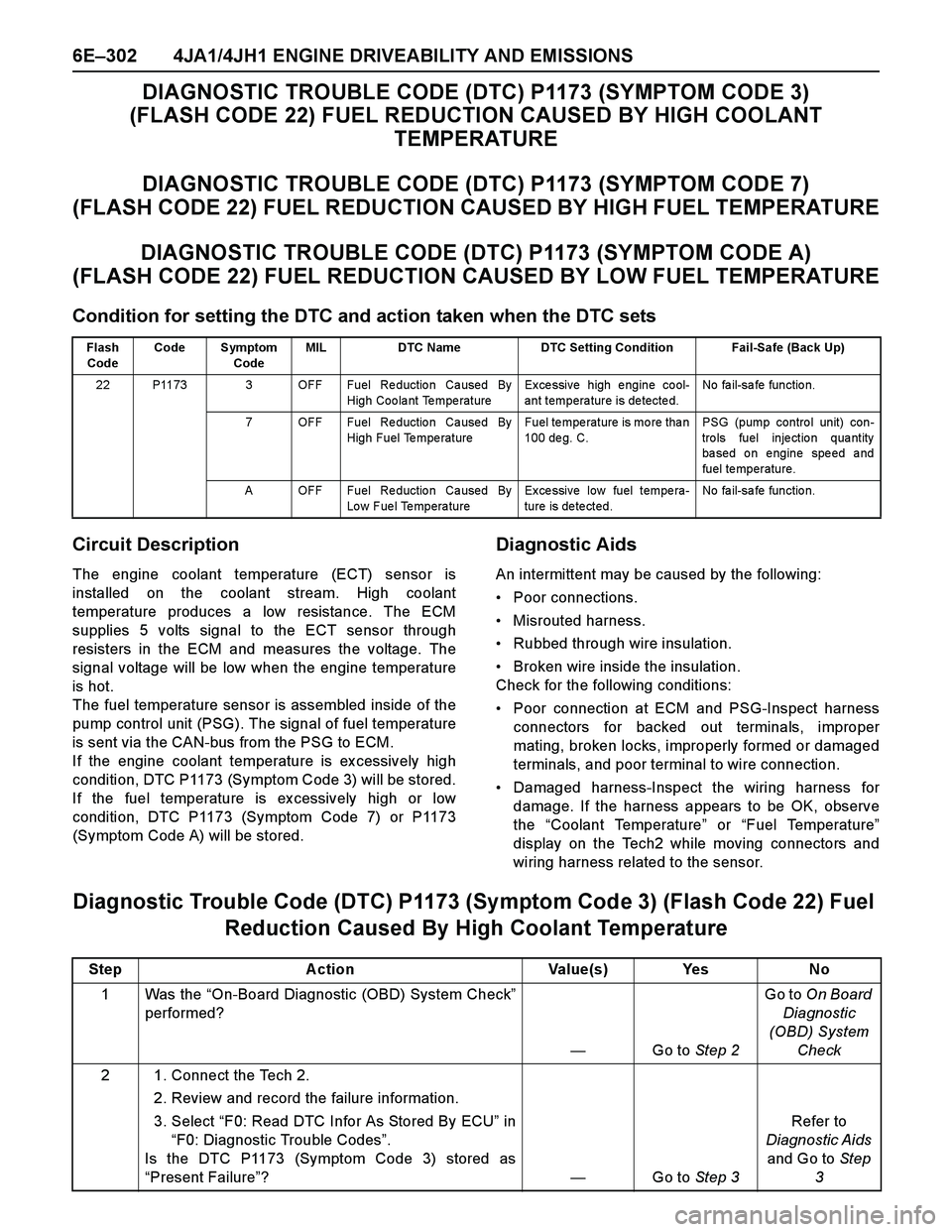
6E–302 4JA1/4JH1 ENGINE DRIVEABILITY AND EMISSIONS
DIAGNOSTIC TROUBLE CODE (DTC) P1173 (SYMPTOM CODE 3)
(FLASH CODE 22) FUEL REDUCTION CAUSED BY HIGH COOLANT
TEMPERATURE
DIAGNOSTIC TROUBLE CODE (DTC) P1173 (SYMPTOM CODE 7)
(FLASH CODE 22) FUEL REDUCTION CAUSED BY HIGH FUEL TEMPERATURE
DIAGNOSTIC TROUBLE CODE (DTC) P1173 (SYMPTOM CODE A)
(FLASH CODE 22) FUEL REDUCTION CAUSED BY LOW FUEL TEMPERATURE
Condition for setting the DTC and action taken when the DTC sets
Circuit Description
The engine coolant temperature (ECT) sensor is
installed on the coolant stream. High coolant
temperature produces a low resistance. The ECM
supplies 5 volts signal to the ECT sensor through
resisters in the ECM and measures the voltage. The
signal voltage will be low when the engine temperature
is hot.
The fuel temperature sensor is assembled inside of the
pump control unit (PSG). The signal of fuel temperature
is sent via the CAN-bus from the PSG to ECM.
If the engine coolant temperature is ex cessively high
condition, DTC P1173 (Symptom Code 3) will be stored.
If the fuel temperature is ex cessively high or low
condition, DTC P1173 (Symptom Code 7) or P1173
(Symptom Code A) will be stored.
Diagnostic Aids
An intermittent may be caused by the following:
Poor connections.
Misrouted harness.
Rubbed through wire insulation.
Broken wire inside the insulation.
Check for the following conditions:
Poor connection at ECM and PSG-Inspect harness
connectors for backed out terminals, improper
mating, broken locks, improperly formed or damaged
terminals, and poor terminal to wire connection.
Damaged harness-Inspect the wiring harness for
damage. If the harness appears to be OK, observe
the “Coolant Temperature” or “Fuel Temperature”
display on the Tech2 while moving connectors and
wiring harness related to the sensor.
Diagnostic Trouble Code (DTC) P1173 (Symptom Code 3) (Flash Code 22) Fuel
Reduction Caused By High Coolant Temperature
Flash
CodeCode Symptom
CodeMIL DTC Name DTC Setting Condition Fail-Safe (Back Up)
22 P1173 3 OFF Fuel Reduction Caused By
High Coolant TemperatureExcessive high engine cool-
ant temperature is detected.No fa il-sa fe fun ctio n.
7 OFF Fuel Re ductio n Ca used By
High Fuel TemperatureFuel te mpe rature is mo re tha n
100 de g. C.PSG (pump contro l unit) con-
tro ls fuel inje ctio n qua ntity
based on engine speed and
fuel temperature.
A OFF Fuel Re ductio n Ca used By
Low Fuel TemperatureExcessive low fuel tempera-
ture is de te cted.No fa il-sa fe fun ctio n.
Step Action Value(s) Yes No
1Was the “On-Board Diagnostic (OBD) System Check”
performed?
—Go to Step 2Go to On Board
Diagnostic
(OBD) System
Check
2 1. Connect the Tech 2.
2. Review and record the failure information.
3. Select “F0: Read DTC Infor As Stored By ECU” in
“F0: Diagnostic Trouble Codes”.
Is the DTC P1173 (Symptom Code 3) stored as
“Present Failure”?—Go to Step 3Refer to
Diagnostic Aids
and Go to Step
3
Page 1678 of 4264
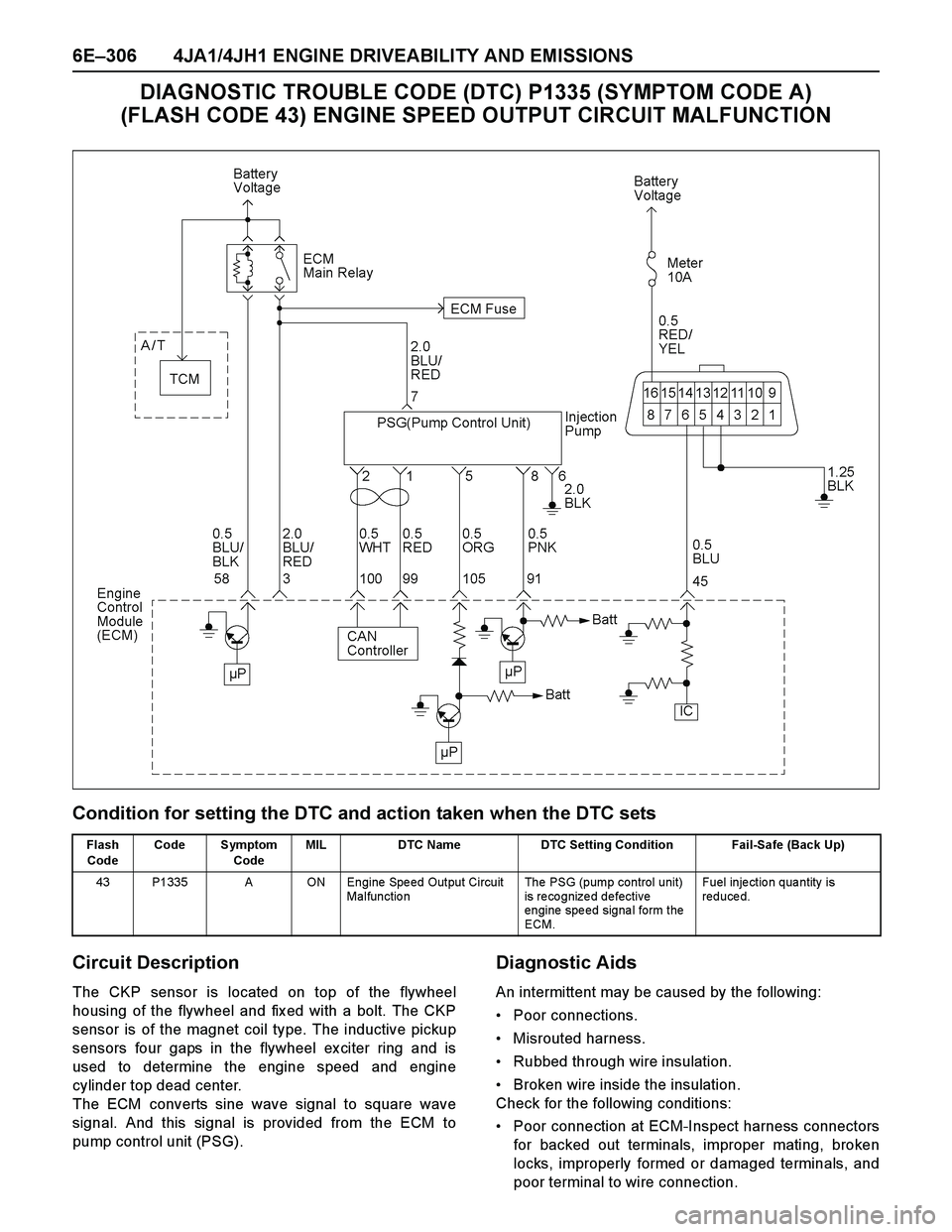
6E–306 4JA1/4JH1 ENGINE DRIVEABILITY AND EMISSIONS
DIAGNOSTIC TROUBLE CODE (DTC) P1335 (SYMPTOM CODE A)
(FLASH CODE 43) ENGINE SPEED OUTPUT CIRCUIT MALFUNCTION
Condition for setting the DTC and action taken when the DTC sets
Circuit Description
The CKP sensor is located on top of the flywheel
housing of the flywheel and fix ed with a bolt. The CKP
sensor is of the magnet coil type. The inductive pickup
sensors four gaps in the flywheel ex citer ring and is
used to determine the engine speed and engine
cylinder top dead center.
The ECM converts sine wave signal to square wave
signal. And this signal is provided from the ECM to
pump control unit (PSG).
Diagnostic Aids
An intermittent may be caused by the following:
Poor connections.
Misrouted harness.
Rubbed through wire insulation.
Broken wire inside the insulation.
Check for the following conditions:
Poor connection at ECM-Inspect harness connectors
for backed out terminals, improper mating, broken
locks, improperly formed or damaged terminals, and
poor terminal to wire connection.
Flash
CodeCode Symptom
CodeMIL DTC Name DTC Setting Condition Fail-Safe (Back Up)
43 P1335 A ON Engine Speed Output Circuit
Malfunctio nThe PSG (pump control unit)
is recognized defective
engine speed signal form the
ECM.Fuel inje ctio n qua ntity is
reduced.
Page 1712 of 4264
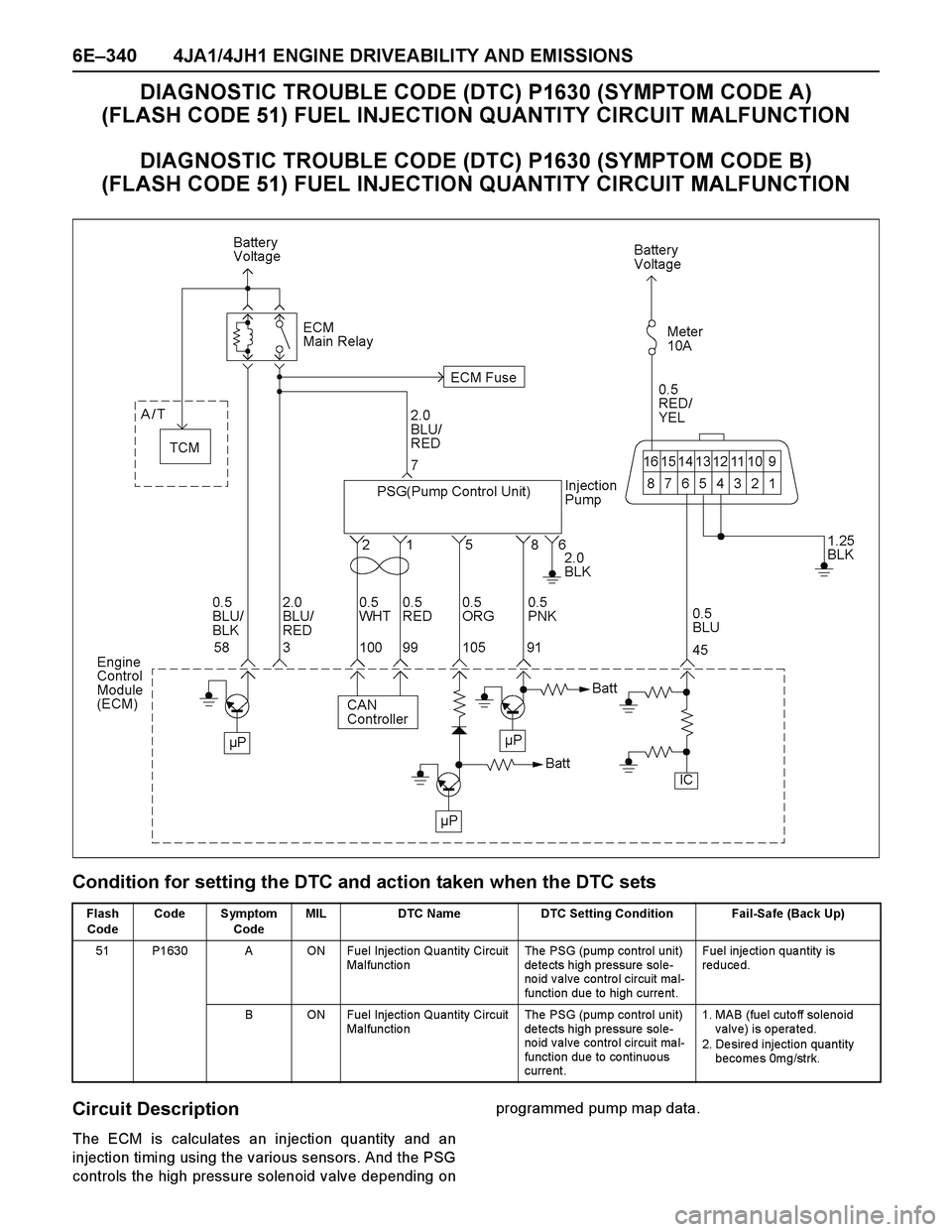
6E–340 4JA1/4JH1 ENGINE DRIVEABILITY AND EMISSIONS
DIAGNOSTIC TROUBLE CODE (DTC) P1630 (SYMPTOM CODE A)
(FLASH CODE 51) FUEL INJECTION QUANTITY CIRCUIT MALFUNCTION
DIAGNOSTIC TROUBLE CODE (DTC) P1630 (SYMPTOM CODE B)
(FLASH CODE 51) FUEL INJECTION QUANTITY CIRCUIT MALFUNCTION
Condition for setting the DTC and action taken when the DTC sets
Circuit Description
The ECM is calculates an injection quantity and an
injection timing using the various sensors. And the PSG
controls the high pressure solenoid valve depending onprogrammed pump map data.
Flash
CodeCode Symptom
CodeMIL DTC Name DTC Setting Condition Fail-Safe (Back Up)
51 P1630 A ON Fuel Injection Quantity Circuit
Malfunctio nThe PSG (pump control unit)
de te cts high pressure sole-
no id v alve contro l circuit ma l-
function due to high curre nt.Fuel inje ctio n qua ntity is
reduced.
B ON Fuel Injection Quantity Circuit
Malfunctio nThe PSG (pump control unit)
de te cts high pressure sole-
no id v alve contro l circuit ma l-
function due to co ntinuo us
curre nt.1. MAB (fuel cutoff solenoid
valve) is operated.
2. Desired injection quantity
becomes 0mg/strk.
Page 1735 of 4264
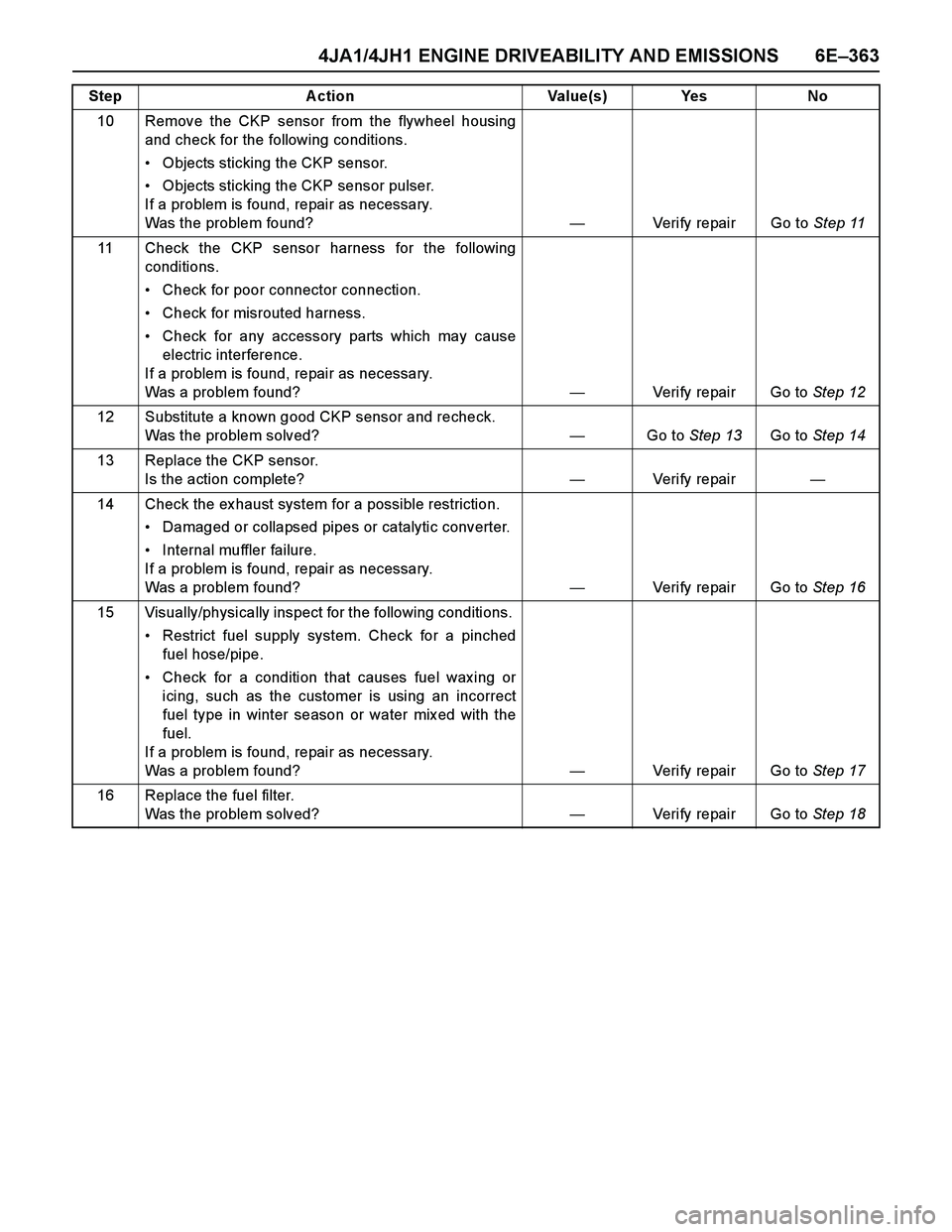
4JA1/4JH1 ENGINE DRIVEABILITY AND EMISSIONS 6E–363
10 Remove the CKP sensor from the flywheel housing
and check for the following conditions.
Objects sticking the CKP sensor.
Objects sticking the CKP sensor pulser.
If a problem is found, repair as necessary.
Was the problem found? —Verify repair Go to Step 11
11 Check the CKP sensor harness for the following
conditions.
Check for poor connector connection.
Check for misrouted harness.
Check for any accessory parts which may cause
electric interference.
If a problem is found, repair as necessary.
Was a problem found? —Verify repair Go to Step 12
12 Substitute a known good CKP sensor and recheck.
Was the problem solved?—Go to Step 13Go to Step 14
13 Replace the CKP sensor.
Is the action complete?—Veri fy repai r—
14 Check the ex haust system for a possible restriction.
Damaged or collapsed pipes or catalytic converter.
Internal muffler failure.
If a problem is found, repair as necessary.
Was a problem found?—Verify repair Go to Step 16
15 Visually/physically inspect for the following conditions.
Restrict fuel supply system. Check for a pinched
fuel hose/pipe.
Check for a condition that causes fuel wax ing or
icing, such as the customer is using an incorrect
fuel type in winter season or water mix ed with the
fuel.
If a problem is found, repair as necessary.
Was a problem found?—Verify repair Go to Step 17
16 Replace the fuel filter.
Was the problem solved?—Verify repair Go to Step 18 Step Action Value(s) Yes No
Page 1738 of 4264
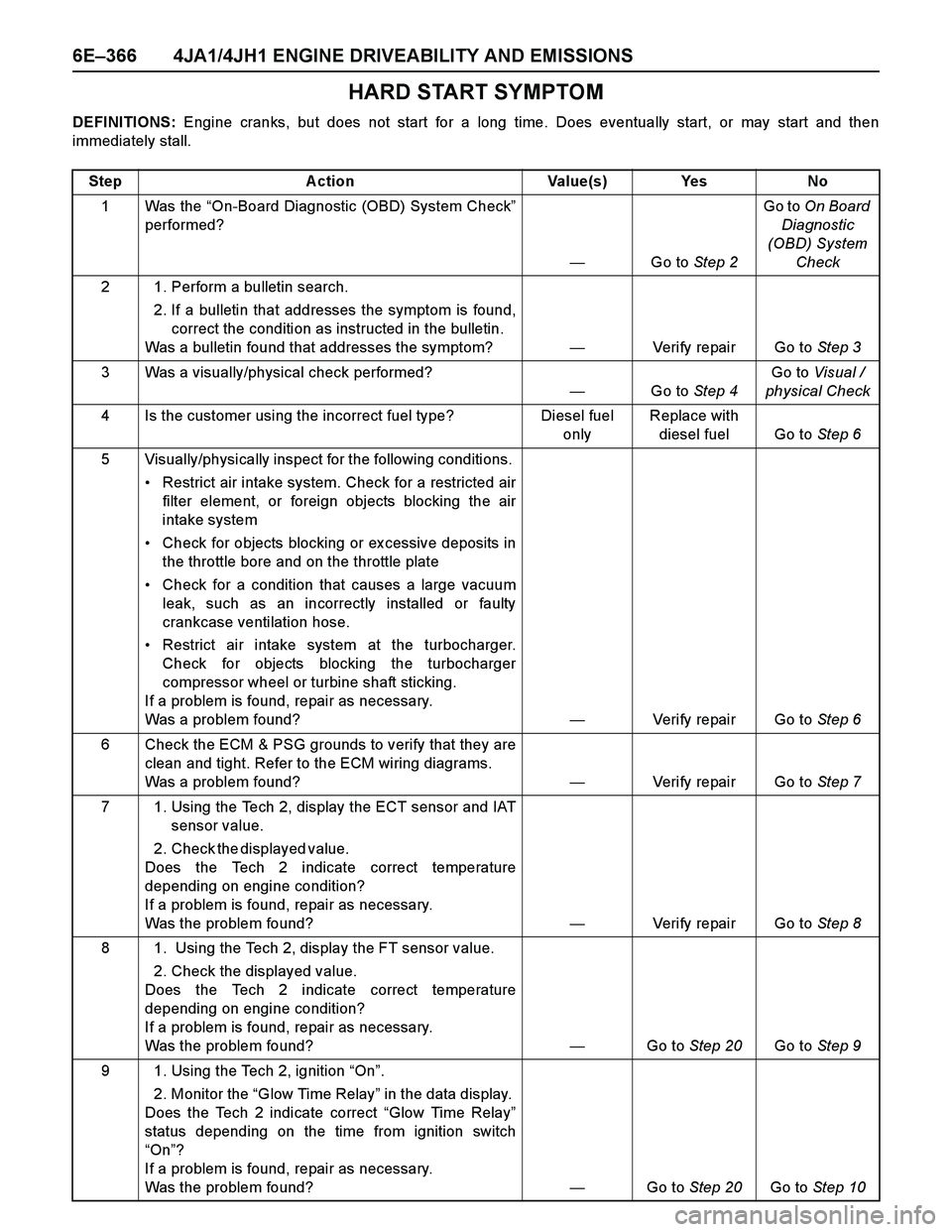
6E–366 4JA1/4JH1 ENGINE DRIVEABILITY AND EMISSIONS
HARD START SYMPTOM
DEFINITIONS: Engine cranks, but does not start for a long time. Does eventually start, or may start and then
immediately stall.
Step Action Value(s) Yes No
1Was the “On-Board Diagnostic (OBD) System Check”
performed?
—Go to Step 2Go to On Board
Diagnostic
(OBD) System
Check
2 1. Perform a bulletin search.
2. If a bulletin that addresses the symptom is found,
correct the condition as instructed in the bulletin.
Was a bulletin found that addresses the symptom?—Verify repair Go to Step 3
3 Was a visually/physical check performed?
—Go to Step 4Go to Visual /
physical Check
4 Is the customer using the incorrect fuel type? Diesel fuel
onlyReplace with
diesel fuel Go to Step 6
5 Visually/physically inspect for the following conditions.
Restrict air intake system. Check for a restricted air
filter element, or foreign objects blocking the air
intake system
Check for objects blocking or ex cessive deposits in
the throttle bore and on the throttle plate
Check for a condition that causes a large vacuum
leak, such as an incorrectly installed or faulty
crankcase ventilation hose.
Restrict air intake system at the turbocharger.
Check for objects blocking the turbocharger
compressor wheel or turbine shaft sticking.
If a problem is found, repair as necessary.
Was a problem found?—Verify repair Go to Step 6
6 Check the ECM & PSG grounds to verify that they are
clean and tight. Refer to the ECM wiring diagrams.
Was a problem found?—Verify repair Go to Step 7
7 1. Using the Tech 2, display the ECT sensor and IAT
sensor value.
2 . C h e c k t h e d i s p l a y e d v a l u e .
Does the Tech 2 indicate correct temperature
depending on engine condition?
If a problem is found, repair as necessary.
Was the problem found?—Verify repair Go to Step 8
8 1. Using the Tech 2, display the FT sensor value.
2. Check the displayed value.
Does the Tech 2 indicate correct temperature
depending on engine condition?
If a problem is found, repair as necessary.
Was the problem found?—Go to Step 20Go to Step 9
9 1. Using the Tech 2, ignition “On”.
2. Monitor the “Glow Time Relay” in the data display.
Does the Tech 2 indicate correct “Glow Time Relay”
status depending on the time from ignition switch
“On”?
If a problem is found, repair as necessary.
Was the problem found?—Go to Step 20Go to Step 10
Page 1768 of 4264
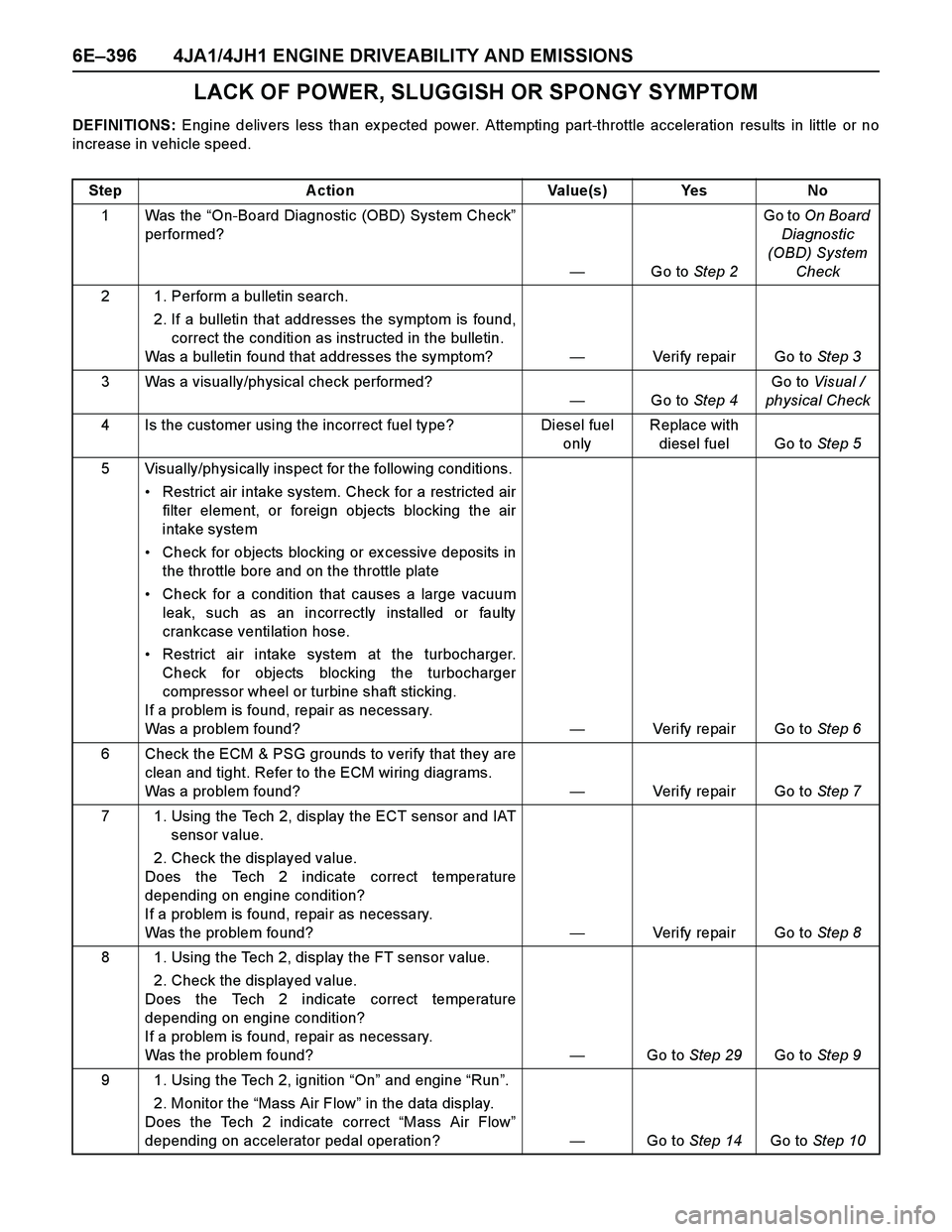
6E–396 4JA1/4JH1 ENGINE DRIVEABILITY AND EMISSIONS
LACK OF POWER, SLUGGISH OR SPONGY SYMPTOM
DEFINITIONS: Engine delivers less than ex pected power. Attempting part-throttle acceleration results in little or no
increase in vehicle speed.
Step Action Value(s) Yes No
1Was the “On-Board Diagnostic (OBD) System Check”
performed?
—Go to Step 2Go to On Board
Diagnostic
(OBD) System
Check
2 1. Perform a bulletin search.
2. If a bulletin that addresses the symptom is found,
correct the condition as instructed in the bulletin.
Was a bulletin found that addresses the symptom?—Verify repair Go to Step 3
3 Was a visually/physical check performed?
—Go to Step 4Go to Visual /
physical Check
4 Is the customer using the incorrect fuel type? Diesel fuel
onlyReplace with
diesel fuel Go to Step 5
5 Visually/physically inspect for the following conditions.
Restrict air intake system. Check for a restricted air
filter element, or foreign objects blocking the air
intake system
Check for objects blocking or ex cessive deposits in
the throttle bore and on the throttle plate
Check for a condition that causes a large vacuum
leak, such as an incorrectly installed or faulty
crankcase ventilation hose.
Restrict air intake system at the turbocharger.
Check for objects blocking the turbocharger
compressor wheel or turbine shaft sticking.
If a problem is found, repair as necessary.
Was a problem found?—Verify repair Go to Step 6
6 Check the ECM & PSG grounds to verify that they are
clean and tight. Refer to the ECM wiring diagrams.
Was a problem found?—Verify repair Go to Step 7
7 1. Using the Tech 2, display the ECT sensor and IAT
sensor value.
2. Check the displayed value.
Does the Tech 2 indicate correct temperature
depending on engine condition?
If a problem is found, repair as necessary.
Was the problem found?—Verify repair Go to Step 8
8 1. Using the Tech 2, display the FT sensor value.
2. Check the displayed value.
Does the Tech 2 indicate correct temperature
depending on engine condition?
If a problem is found, repair as necessary.
Was the problem found?—Go to Step 29Go to Step 9
9 1. Using the Tech 2, ignition “On” and engine “Run”.
2. Monitor the “Mass Air Flow” in the data display.
Does the Tech 2 indicate correct “Mass Air Flow”
depending on accelerator pedal operation? —Go to Step 14Go to Step 10